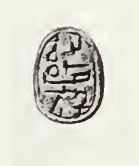| 'Ammu Aahotepre | |
|---|---|
 Scarab seal with the prenomen Aahotepre | |
| Pharaoh | |
| Reign | c. 15 years, 1760 BC-1745 BC |
| Predecessor | Qareh Khawoserre[1] |
| Successor | Sheshi Maaibre[1] |
| Dynasty | 14th Dynasty |
'Ammu Aahotepre was a pharaoh of the 14th Dynasty who ruled over parts of Egypt during the Second Intermediate Period.[4][1] His reign is believed to have lasted about 15 years, from 1760 BC until 1745 BC.[5]
Attestations
Like other kings of the dynasty, scarab seals are the only surviving evidence for his reign. 'Ammu Aahotepre has 61 seals bearing his name: 30 for the nomen 'Ammu and 31 for the prenomen Aahotepre.[5]
A scarab bearing the nomen of this king was discovered in Tell el-Ajjul, Gaza Strip and catalogued by Flinders Petrie in 1933.[6]
Identification
Ryholt (1997) identified king 'Ammu with Aahotepre in his reconstruction of the Turin canon.[1] Von Beckerath (1964) had previously assigned the prenomen Aahotepre to a pharaoh of the Sixteenth dynasty of Egypt.[7]
See also
References
- ^ a b c d Ryholt 1997: 50
- ^ Aahotepre on Eglyphica.de
- ^ Petrie, Flinders (2014-01-25), English: Scarab of Aammu, whom Ryholt identifies with Aahotepre, possibly 14th dynasty or otherwise a vassal of the 15th dynasty. Drawing by Flinders Petrie 1897., retrieved 2023-01-13
- ^ Hayes 1973: 64
- ^ a b Ryholt, K. S. B.; Bülow-Jacobsen, Adam (1997). The Political Situation in Egypt During the Second Intermediate Period, C. 1800-1550 B.C. Museum Tusculanum Press. p. 199. ISBN 978-87-7289-421-8.
- ^ Flinders, Petrie (1933). Ancient Gaza Chapter III: Scarabs Tell El Ajjul (London, 1933).
- ^ Ryholt 1997: 324 n. 1116
Bibliography
- von Beckerath, Jürgen (1964), "2. Zwischenzeit", Archiv für Orientforschung
- Hayes, William C. (1973). "Egypt: From the death of Ammenemes III to Seqenenre II". The Cambridge Ancient History. Vol. 2. Cambridge: Cambridge University Press..
- Ryholt, K. S. B. (1997), The Political Situation in Egypt during the Second Intermediate Period, c. 1800 - 1550 BC, Copenhagen: Museum Tusculanum Press, ISBN 87-7289-421-0
